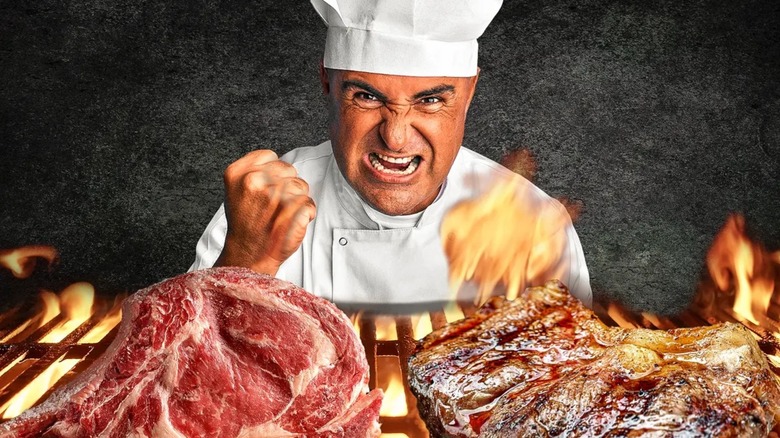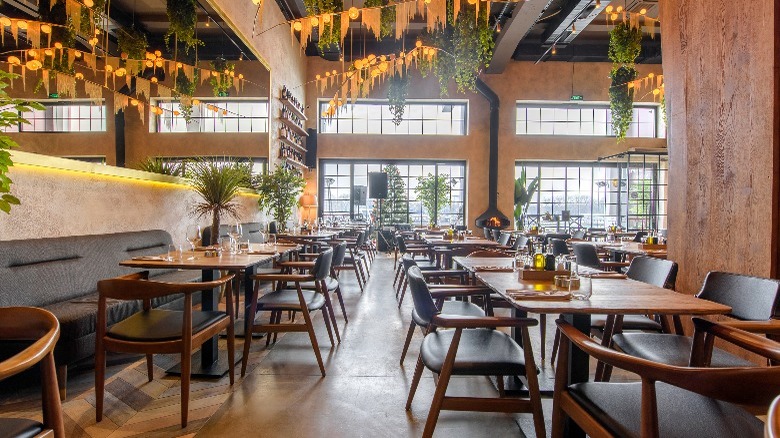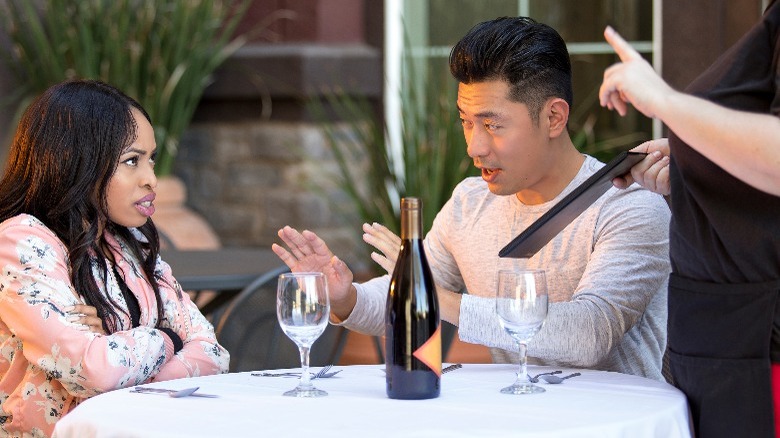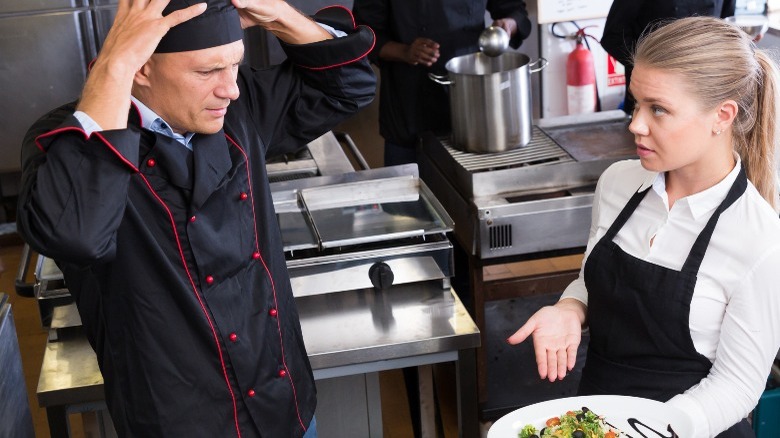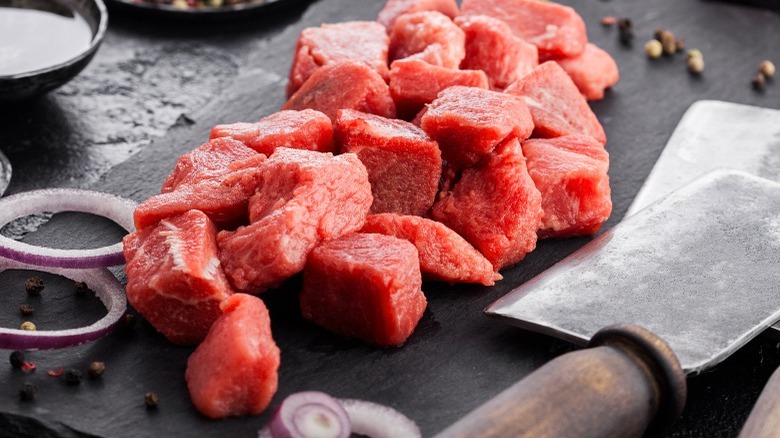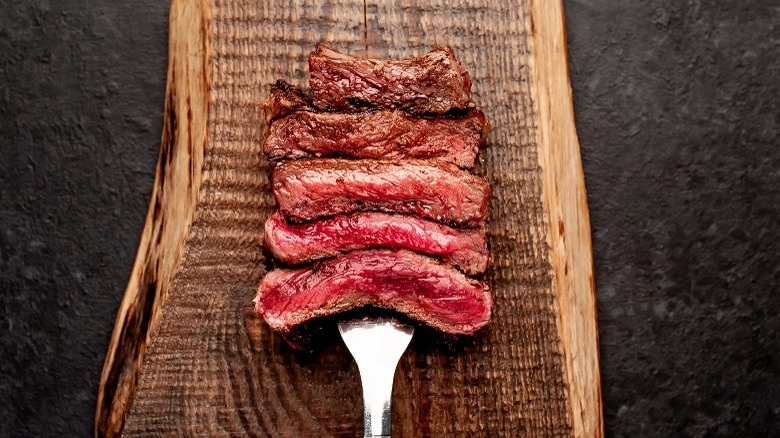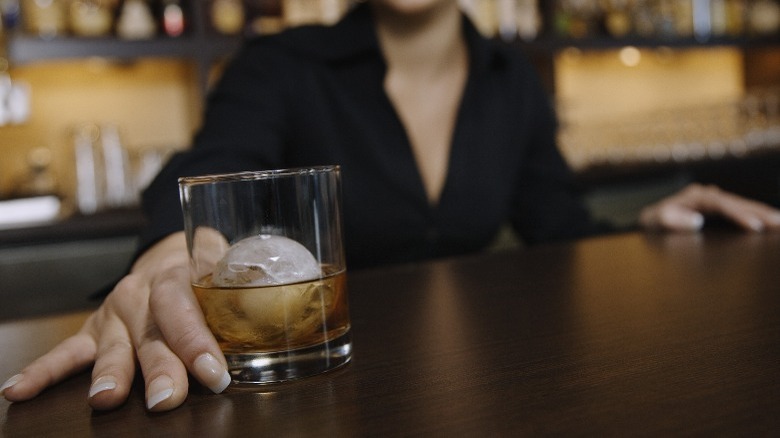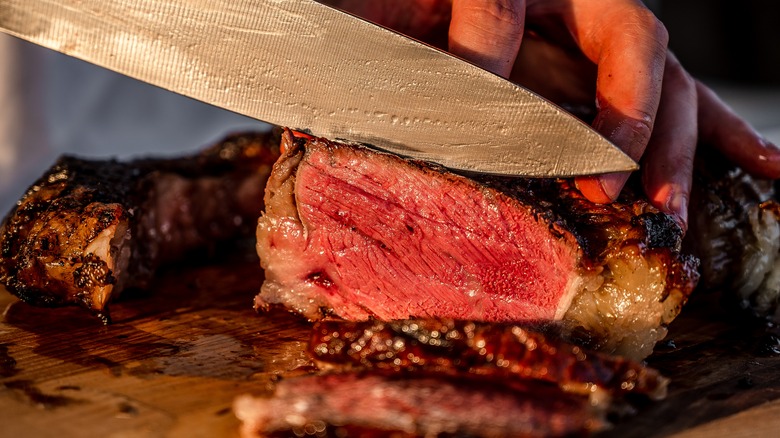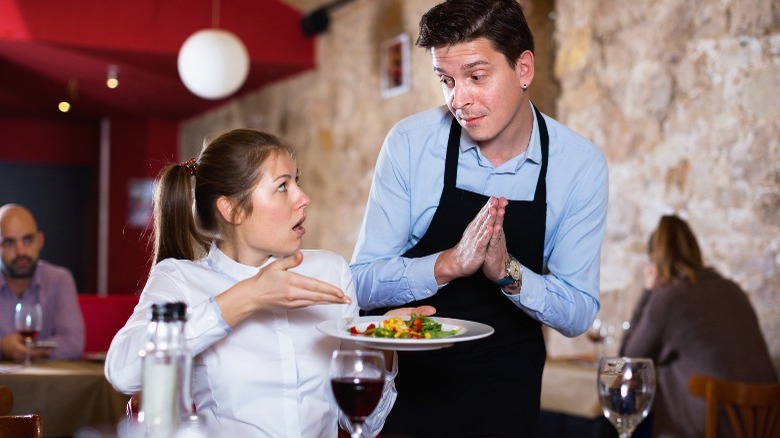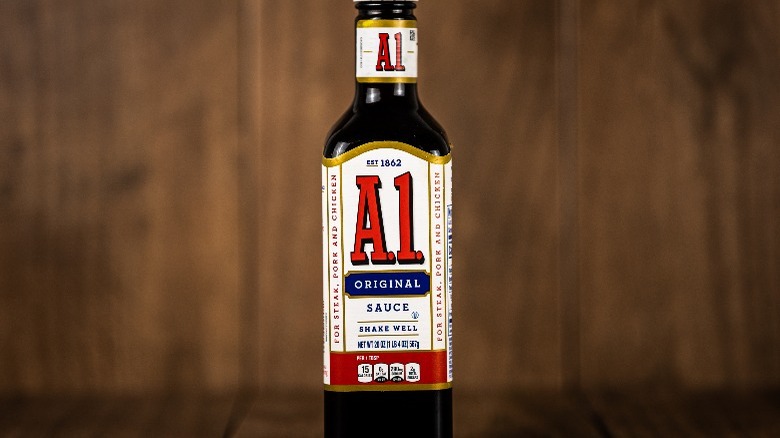16 Red Flags At A Steakhouse That Should Make You Turn Around
There is something primal about sinking your teeth into a charred hunk of meat. Pair that deeply rooted fondness with a formal dining setting and a full-bodied glass of cabernet sauvignon, and your gluttonous heart will indeed glow with great pleasure.
When you first walk through the doors of a top-notch steakhouse, you should be welcomed by a wafting aroma of juicy steaks and stunning plates of food. There are plenty of great steakhouses across the country, many of which have the details down pat. Some others, however, need a little help in categories across the board.
A gorgeous flame-kissed ribeye or petite filet mignon might be the star of one's steakhouse experience, but there are other valuable details to pay close attention to. By "valuable details," we mean red flags. Whether you are a self-proclaimed gourmand or have a passion for sizzling steaks, there are a lot of justifications to determine whether your experience is worth your dime. From slow, unfriendly service to mediocre menus, consider these red flags a sign that you should turn around and go elsewhere.
1. It's a ghost town when you go
Good first impressions are critical. It's why you're "extra" polite when you meet someone new. It's also why you clean your house up really nicely before guests visit. When your first impressions are less than great, people tend to remember those not-so-great details before pursuing anything further.
When it comes to a quality steakhouse, consider the number of cars parked in the parking lot your first impression. This critique, of course, should first be made according to the time and day of your dining excursion.
For example, if you show up at the steakhouse at 3:00 p.m. on a Tuesday, chances are, you won't have much competition for suitable parking spots. However, if you pull up to the steakhouse on a Friday or Saturday during prime dinner time, that parking lot should be pretty packed. If it's a ghost town, you might want to consider going elsewhere.
2. Service is slow and unfriendly
It's one thing to drive up to a steakhouse and find a nearly empty parking lot, but dealing with slow or unfriendly service is a huge red flag that should make you turn around. Going out to eat and paying top dollar for a tasty steak is about more than just food. It's an experience.
Any time you dine out, you should expect quality service, but because steakhouses tend to be pricier than other dining establishments, your server better be prompt, attentive, and genuinely friendly. Quality steakhouse managers should take pride in hiring employees that are a good fit and also train them well.
Slow and unfriendly service is typically an indication that managers in charge aren't fully invested in hiring the right employee for the job or don't offer a successful training program. If you find yourself stuck dealing with someone's rude 'tude, you might as well take your money elsewhere.
3. The bathrooms are unkept and gross
The cleanliness of a steakhouse (or any dining establishment, for that matter) is by far one of the most important values any restaurant should uphold. Keeping a steakhouse clean means keeping the dining room and the kitchen regularly cleaned throughout the shift. Not only is this a matter of ambiance out front, but your guests will feel good eating there.
Anyone paying $50 for a ribeye won't find the same joy of a good meal while their forearms stick to the tables or if they find lipstick stains on their drinking glass. While these icky flukes are no fun to run into while dining out, there is another way to judge how clean a restaurant is.
You obviously won't be able to find your way to the kitchen to check cleanliness, but there is one room you can always check — the bathroom. If the restroom is glimmering clean, it's a good indicator that managers care and keep other parts of the restaurant clean, too.
4. Your server is not knowledgeable about cuts of steak
Your server doesn't need to be a former esteemed chef with a culinary arts degree up their sleeve before greeting you and serving your needs. It is essential, however, that they are incredibly well-versed in the steakhouse's menu, especially the steak cuts.
When a guest comes to the steakhouse for the first time, they should be able to ask questions about each cut of meat and make a selection based on the details provided by their server. The amount of marbling, the cooking method, and the types of seasoning are all essential information that will demonstrate your server's knowledge.
An experienced server is usually easy to pick out, but paying top dollar in a steakhouse means no matter how talented or competent your server is, it shouldn't matter. Your server should be well-trained and masterful in explaining cuts of steak without question.
5. The steaks are far too cheap
While we all love a good meal that doesn't break the bank, you shouldn't buy a cheap steak when dining out at a steakhouse. When perusing the menu, you'll find the price tag is quite a good indicator of meat quality. Another good indicator is that the menu proudly advertises that the beef they use is prime-grade.
The United States Department of Agriculture grades beef on quality based on several details, including how the cattle are fed, and the amount of marbling on the cut of meat. Unfortunately, you'll find some steakhouses sell USDA choice-grade beef, which is of lesser quality than prime. If you want to enjoy your meal, don't bother paying for a $10 steak. Not only will the beef itself taste less than mediocre, but you're probably looking at a tough steak coated with way too much seasoning to try and mask the poor quality of the beef.
6. There are no details about the steak on the menu
A steakhouse's menu (and website) ought to proudly advertise noteworthy details about its steaks. You already know USDA grade shields help identify the quality of a steak, but the origin, spotlighted local ingredients, and age of steaks are all relevant as well.
Origin is an important detail that helps patrons understand precisely where the cattle are raised before enjoying a steak. For example, Ruth's Chris Steak House Cowboy Ribeye advertises as midwestern USDA Prime Beef. If the menu offers a steak grilled from Kobe beef, then you know you have a prized steak from Japan that is highly regarded for the amount of generous marbling.
Some fancier steakhouses might also offer dry-aged steaks, which yield pricier plates. The results of an aged steak are exquisite, with deep beef flavor that meat lovers can't get enough of. All of these details help provide additional information to guests and show authority in a steakhouse.
7. Degrees of doneness aren't described
Every steakhouse you go to should offer descriptions for degrees of doneness specific to the dining establishment. A description for a particular degree of doneness, or steak temperature, helps the guest understand what they should receive when ordering a steak at a specific temperature.
For example, when a guest orders a rare steak at Ruth's Chris Steak House, the server is trained to tell the guest that the steak will have a "very red cool center." The menu also offers these descriptions to allow guests to learn what the steak temperature will look like and how hot or cool it will be upon arrival at the table.
Steakhouse chains like LongHorn Steakhouse commonly offer descriptions, as do fine dining locations like Ruth's Chris and The Capital Grille. Learning to repeat the descriptions is an important part of server training to both make guests comfortable and avoid room for error.
8. Side dish selections are underwhelming
We all know that the steak list is the most crucial section on a menu, but side dishes can undoubtedly make or break your dining experience, and here's why. Side dishes are not just there to allow someone to add a little green to their plate — they're meant to complement a steak while adding a little inspired taste to your meal.
Steakhouses that offer brilliant flavor combinations in side dishes show that they are willing to go above and beyond on everything on the menu beyond their entrees. If you notice unique sides like roasted wild mushrooms over bleu cheese-crusted mashed potatoes, then you can consider your dinner will be out of this world.
While baked potatoes, side salads, and grilled asparagus are all good reliable options, it's always fun to try new unique sides. It shows the chef in charge cares about sending out quality food, no matter what the plate size is.
9. The red wine list variety is poor
There's a good chance you have heard that red wine and steak go well together, and there is a reason for that. Red wine is typically high in tannins, which taste somewhat bitter. That bitter taste pairs beautifully with a rich fatty steak, making them quite a match.
A nice bottle of cabernet sauvignon tends to be a top choice for pairing steak because of those tannins, thanks to the bold, full-bodied taste in each sip. Steakhouses almost always offer a selection of red and white wines, but having a generous variety of red wines is especially important. This allows guests to select a wine that suits their taste buds and wallet depending on price. Not having an abundance of bottles to choose from demonstrates that the steakhouse does not pay close attention to essential details, such as pairing with complementing beverages.
10. Limited options of quality whiskey
If someone isn't much of a wine drinker, whiskey is another excellent option, so steakhouses need to offer well-stocked whiskey sections, too. A proud display of whiskey boasts authority in a steakhouse and demonstrates that the establishment goes above and beyond with essential pairing details.
Whiskey, depending on the type, offers all sorts of rich flavors. Some are mellow with vanilla or caramel notes, while others boast light smoky flavors. That type of hearty richness complements a steak beautifully.
If a steakhouse offers a "house whiskey" plus one or two top-shelf bottles, then we can give them a C-minus for putting in minimal effort. For a whiskey connoisseur, you better bet having few or no options will serve as a big red flag and cause them to turn around and go elsewhere.
11. Your server seasons your steak by sprinkling salt down their arm
If you haven't had the privilege (ahem) of watching Salt Bae's 36-second video to fame, please do so before reading on. The 2017 video clip caused restauranteur Nusret Gökçe (best known as Salt Bae) to explode in the culinary world.
The trend was hot, and many adored his social media videos, but it wasn't long before the cultural phenomenon took a back seat. Between questionable tip disputes with servers to overpriced steaks, there's no doubt Salt Bae's Instagram account made his head a little too big.
So, if you ever find yourself in a steakhouse where this strange salting technique comes to light, do yourself a favor and run. It's nothing more than a viral internet gimmick. Honestly, it is also just plain weird and unsanitary too.
12. Juices are pooling when your steak is served
As you hungrily await for a behemoth steak to come out to the table, you can probably envision the gorgeous sear marks or grill lines that will embellish the outside. One detail you probably don't picture is your steak arriving in a pool of liquid.
Steakhouses typically allow their steaks to rest for a few minutes before sending them out to guests. This helps keep those precious juices in the steak before being cut into. Cutting into the steak or poking it with a thermometer too often will cause all those juices to pool out and dry your meat.
Any steakhouse that temps their steaks too often or (cuts into the steak to check its temp) is a place you want to steer very clear from. Keep in mind; there are some steak dishes that typically arrive on the table pre-sliced, like steak frites. Your menu should specify that the steak will come sliced.
13. Steaks are consistently cooked incorrectly
There are plenty of reasons to send a dish back at a restaurant, and an incorrectly cooked steak is undoubtedly one of them. It's inevitable for cooks to make mistakes, especially when they are new and learning. However, if you send incorrectly cooked steaks back often every time you visit a steakhouse, you're looking at a red flag.
While we can excuse flukes every so often (as they are bound to happen), it's unacceptable for anyone to deal with that frequently. If it happens often, it's typically a little bit more than an issue of a new employee learning the ropes. Instead, it's likely a result of high employee turnover or lack of proper training. A quality steakhouse should take pride in its training program and do its best to hire the right person for the job to avoid these issues from occurring often.
14. Your steak is clearly not properly trimmed
There is nothing worst than paying top dollar for a quality steak to find it has not been trimmed properly. Beef contains two types of fat — intramuscular and intermuscular. Intramuscular fat is those thin strips of white fat found within the steak itself, known as marbling. Marbling is a beautiful thing. It helps provide top-notch flavor and succulent tenderness with every bite.
Intermuscular fat is the noticeable thick hunks usually found outside your steak. This type of fat doesn't melt like marbling, making your eating experience a little less enjoyable if not properly trimmed. Some steaks, however, like the ribeye, come with more fat than others, and many people genuinely enjoy it that way.
Beef also contains two types of connective tissue: elastin and collagen. Elastin is most commonly known as gristle. If you have ever had the displeasure of chewing on an unpalatable steak that doesn't seem to break down with your teeth, you've experienced gristle. Steakhouse chefs should understand how to properly trim a steak, especially if they broil or grill steaks at high temperatures. Since fat burns faster than meat, having access amounts on your steak while cooking at high temps can cause your steak to burn and taste awful.
15. Servers offer you bottled steak sauce
Here's the thing about an impeccable steak: it doesn't need much more than quality seasoning and butter. Besides that, the meat itself should really be the star of the show.
Steakhouses should not offer bottled steak sauce, although most steakhouses do carry it in case a guest requests it. The real reason offering steak sauce is a big no-no is that it demonstrates that the employees of that steakhouse believe the steaks you provide — and that guests are paying for — need extra flavor. In fact, some steakhouses, like LongHorn Steakhouse, specifically train their servers to never offer steak sauce for that exact reason. Instead, steak sauce will be delivered at the guest's request. While it's definitely a big red flag for servers to offer steak sauces, it's an even bigger red flag if you arrive at your table to find a bottle ready to go by the salt shakers.
16. The managers don't make things right when necessary
An effective manager is great at multitasking and problem-solving and will encourage a kind and honest culture for their employees. With guests requesting managers and employees asking questions during busy shifts, managers have a lot to juggle while staying cool.
While restaurant managers wear many hats while in their role, they must always stay vigilant about a fundamental matter: keeping the guest happy. So when an issue arises and a guest requires a visit from the manager, the manager should always attempt to make things right. That doesn't mean every little fluke deserves a free steak. However, at the very least, a manager's role is to visit the table, listen to the guest, and bounce back from the issue. Sometimes that means taking the steak back and providing remarkable recovery. Other times, it might mean giving a small discount or offering a free dessert.
Static Media owns and operates Tasting Table, Mashed, and The Daily Meal.
